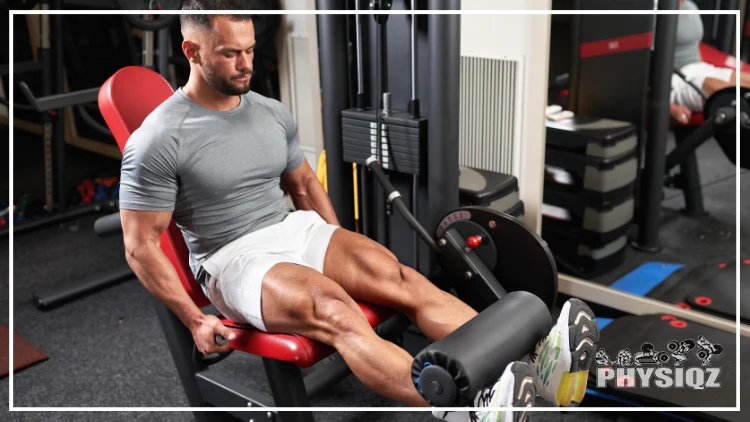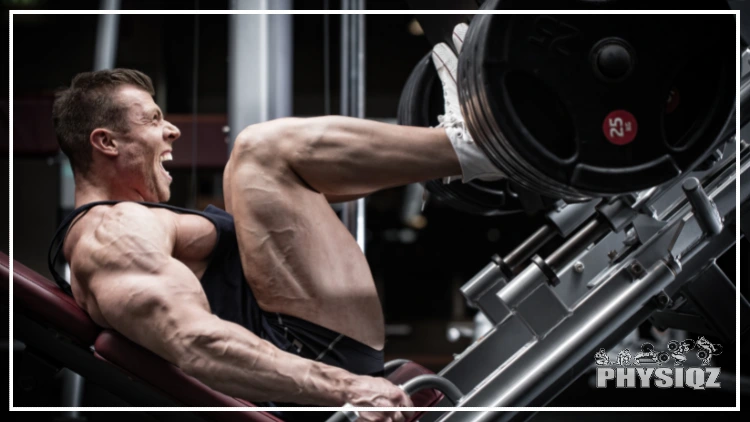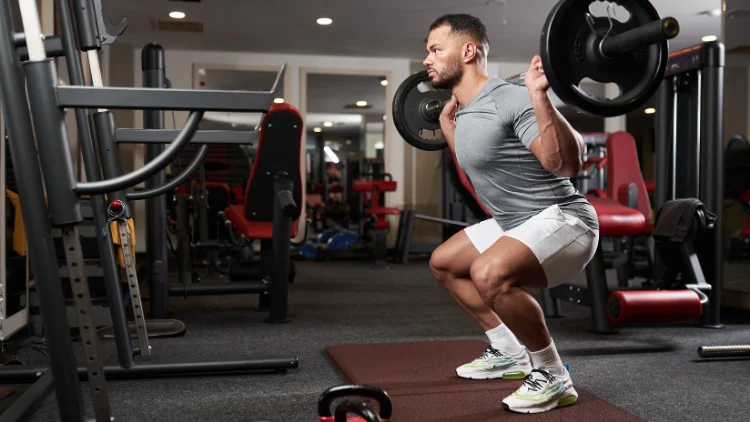
Training legs three times a week might seem excessive, especially considering how demanding leg workouts and compound movements like squats can be. While concerns about overtraining are valid, the belief that training legs this frequently is always too much is only partially accurate; often, it’s not necessarily excessive.1
To elaborate, when it comes to the frequency of leg training, what truly matters is the overall volume performed, how the body is handling that volume (volume indicators), if the lifter is using periodization appropriately, and the stimulus to fatigue ratio of the exercises chosen.
So before haphazardly training legs 3x per week, be sure your programming considers the information above to maximize your returns in the gym.
Why Frequency Matters When Training Legs
The key to training legs as with any other muscle in the body is the frequency at which it is worked. Frequency in a resistance training program is a reference to the number of sessions the muscle group, in this case the legs, receives a workout in a time period or the number of times that the muscle group is worked over a set time.2
It is an important component of leg training and studies have shown that training the muscle group twice a week compared to once a week results in increased muscle hypertrophy (growth). The legs have the largest muscles in the body and working them is challenging but they need proper and constant stimulation to grow akin to what a progressive overload workout plan will entail.

Source: Ibrakovic via Canva.com3
Put simply, the more you train a muscle, the more it grows as can be expected from a logical point of view, but only to a certain point. It is important to give the leg muscles time to recover especially when they have experienced delayed onset muscle soreness (DOMS)—this is the body’s reaction after a workout that results in soreness coming 12-24 hours after an intense workout and subsiding after about 72 hours.4 Allowing the body to recover will prevent over training as well as preventing injury.
Is Training Your Legs Three Times a Week Overdoing It?
Training legs multiple times a week may be okay in many cases, training them three times a week can be good in some cases, and bad in others—when legs are trained 3 times a week it ends up becoming counterproductive when periodization is not being done correctly. Periodization is the manipulation of the training variables which are weight, reps and sets to ensure that overtraining does not take place.5
In other words, it all depends on volume and volume landmarks. Training volume is considered the intensity of the workout and is a product of the number of reps, by the weight load and the total number of sets.6 In regards to volume landmarks, there are 4 principles that pertain to this and briefly are:
- Maintenance volume (MV)—training volume needed to maintain muscle growth
- Minimum effective volume (MEV)—the minimum volume needed to achieve muscle growth
- Maximum adaptive volume (MAV)—this is the amount of weights the body can handle before becoming desensitized to the load.
- Maximum recoverable volume (MRV)—this is when the volume becomes greater than recovery which leads to progress being hindered.
Paying attention to someone’s landmarks will determine if they are indeed able to train legs 3 times a week. It will depend on the volume intensity and how it relates to the volume landmarks.
While it will be possible to train legs 3 times a week, care should always be taken to ensure the MRV is not exceeded and the MV is maintained, at minimum, the MEV should be executed within the range of the MAV.
When Is Working Out Your Legs Three Times a Week Excessive?
It’s important to consider that training legs three times a week can be excessive if the maximum recoverable volume is surpassed. For instance, going beyond these volume landmarks could lead to overtraining.
To put this into context, if a lifter puts in a training volume that is greater than the their MRV and not give the muscles enough time to recover from DOMS, this hinders progress to pack on muscle since the muscles do not have enough time to regrow, repair and adapt to the stress placed on them.
A lifter wondering why they are getting stronger but not bigger would be wise to pay attention and be aware of these landmarks, by for example deloading leg training when MRV has been reached to prevent injury and continue muscle growth.
Subsequently, when a lifter exceeds the workout past the maintenance volume (MV), they are introducing what is known as junk volume. Training legs 5 days a week, would be counterproductive and subsequently, in some cases for some lifters depending on their training intensity and volume landmarks, working the legs 3 times a week does not lead to gains.
Is Working Out Your Legs Once a Week Enough?
Individuals who are new to working out or on beginner powerlifting programs will usually train using either body weight or with light weights and training once a week may be sufficient. They may choose to train legs once a week because their training goals are different from the experienced lifter who has accrued longer time training. In this scenario, training legs once per week will be sufficient as training this way ultimately prepares the body for heavier weights in the future.
However, it should be noted that training legs once a week for experienced lifters will not be sufficient. They are likely not to hit both MV and MEV. It is also likely that due to the decreased frequency MAV will also not be attained—as a result it is very likely that gains will be slow in coming or training plateaus will be hit due to insufficient stimulation.
How Often Should You Train Your Legs Each Week? How Frequently Should You Train Your Legs?
Training legs either too infrequently or too excessively can lead to poor outcomes for the lifter, ranging from minimal results to potential injuries. It is important to determine the optimal frequency of leg training sessions per week. In most cases. legs should be trained at least twice a week for both quads and hamstrings. The maintenance volume for quads should be roughly 6 sets per week and hamstrings should receive 3 sets a week.

Source: Kzenon via Canva.com7
It is possible however to do the 6 sets a week in one session when training legs once a week and still have the same calorie burn and workout. The glutes in most cases receive adequate training during back squats or other quad intensive workouts. Their number should coincide with quad training.
Training legs three times a week is generally manageable, but it might be advisable to reduce the frequency to twice a week if symptoms of DOMS persist. This suggests that the training volume may be too high. The leg muscles need to be given time to recover and repair themselves to prevent the impediment of progress. The maximum times legs should be trained in a week is 4.
How Exercise Selection & Stimulus to Fatigue Ratio Affect Training Frequency
Just like any other body part, exercise selection can largely impact how often you should train. This is because some exercises do not tax the body as much as others.
For example, squats and deadlifts have a very high stimulus to fatigue ratio because they’re very stimulating, but also very, very taxing. So if you’re squatting heavy loads 3x per week, then this can easily develop into fatigue. On the other hand, lunges or split squats have a fair amount of stimulus, but they’re not very taxing.
So if you simply do leg extensions, leg curls, calf raises and other exercises that have a low stimulus to fatigue ratio, then training legs 3x per week is unlikely to cause excessive fatigue with proper programming and deloads.
For a further explanation, check out this video or at least read the slides to fully comprehend stimulus to fatigue ratio (SFR) and how it impacts how often you should train legs.
How Many Leg Sets Should I Do Each Day?
The number of sets that should be trained on the legs per day should be done by aligning with the various landmarks aforementioned. Both quads & glutes and hamstrings have varying numbers of sets to be recommended to be done in a day.
Quads & Glutes
In the case of both intermediate and advanced lifters, 8 sets of direct quad and glute training per week would suffice to ensure gains are being made and not left on the table. Assuming the lifter is training twice a week, that would translate to 4 sets per session and around 2-3 sets per session if the lifter is hitting the legs thrice a week.
The MAV should not be below 4 sets per session and not exceed 12 sets per session. To ensure there is no overtraining, the MRV for 2 weekly leg sessions would be 18 sets per week. Lifters that are working legs 3 times a week, should have a MAV of around 22 sets per week.
The type of workout will also have an effect of the MRV’s for quads and glutes—typically squatting will lead to lower MRV’s due to the fatigue created, but leg extensions will have higher MRV’s since they are less taxing.
Hamstrings
Since 2 weekly sessions are sufficient for hamstrings, the maintenance volume (MV) would be about 1-2 sets in each session; although it is possible if the hamstrings are being hit once a week, that 3 sets can be worked on that day.
In the case of both intermediate and advanced lifters, 4 sets of direct hamstrings training is sufficient for muscle gains. This translates to 2 sets per session if the lifter is training legs twice a week, or 1-2 sets per session when the legs are being trained thrice a week.
Is It Alright to Repeat the Same Leg Workout Three Times a Week?
Doing the same leg workout 3 times a week may be acceptable in some situations and may have some advantages and disadvantages—however as long as the training is done within the prescribed volume landmarks, then there should be an increase in muscle mass and strength.
Advantages
The below are the pros of doing the same leg work out 3 times a week:
- The muscles will receive sufficient stimulation to strengthen and grow.
- There will be an improved mind muscle connection as a result of the repetitive nature of the exercises. Mind muscle connection is essentially thinking about engaging the muscle actively as you train it—that is being aware of the muscle during exercise—increased mind muscle connection leads to increased muscle growth.8
- The lifter will be able to perfect their technique and form when training the leg in the same way; practice makes perfect. However, this will only be beneficial if the form and technique are correct.
Disadvantages
There will be cons to training the leg the same way and these are:
- The targeted leg muscles may tend to get overused which may lead to overtraining and injury down the road.
- As a result of hitting the leg muscles in the same way, training plateaus can easily be reached. Training plateaus are attained when the muscles over time become more efficient at doing an exercise leading to less muscle growth and burning fewer calories.9
- Muscle imbalances may develop with certain muscles being over developed and others under developed.
- Lifters can get tired of doing the same workout repetitively which may lead to loss of excitement.
While it may be Ok to train the leg muscles the same way 3 times a week, it is always a good idea to introduce variety into the workout by working the leg muscles in a different way—spicing things up in the exercise regimen and not sticking to the same routine is beneficial; progress cannot be achieved optimally if the leg muscles are being worked with the same motions.10
Subsequently, utilizing daily undulating periodization which involves varying the training variables (volume and intensity) will help stave off training plateaus. In this way, the legs are constantly being challenged and as a result become well balanced.
Workout Split 3 Day Leg Workout Program
A workout split program is dividing a workout program by either body region, lift or movement—in the case of the 3 day workout split program, the regimen is centered on combining upper and lower body (legs).

Source: Slatan via Canva.com11
Workout split programs are just as effective as full workout programs for muscle gains in both the upper and lower body.12 Full body workouts include the 4 day workout split program that is also effective for hypertrophy, but this program trains the legs once in a 4 day cycle.
Training legs three times a week isn’t always excessive. The misconception that it is often too intense has been partially debunked by the success of the three-day workout split program outlined below. This regimen has proven effective for numerous elite powerlifters and bodybuilders, enabling them to achieve significant gains while adhering to optimal volume benchmarks.
Day 1: Developing Leg Strength
- Body Squats: 5 sets of 3 reps
- Barbell Back Squats: 3 sets of 5, 3, 2 reps
- Romanian Deadlifts: 3 sets of 5 reps
- Crunches: 3 sets of 10-30 reps
Day 2: Developing Leg Support
- Kettlebell Swings: 3 sets of 50, 25, 15 reps
- Goblet Squats: 3 sets of 10 reps
- Single-Leg Bench Hip Thruster: 3 sets of 20 reps each side
- Farmer’s Walk: 3 sets of 40 meters reps
Day 3: Developing Leg Muscle
- Front Squats: 5 sets of 5 reps
- Walking Lunges: 3 sets of 20 steps reps
- Leg Curls: 3 sets of 8-12 reps
- Sled Pushes: 3 sets of 60 seconds reps
It should be noted that the next day after leg day 1 is reserved for the upper body and a rest day afterwards before going for leg day 2 followed by upper and body and so forth.
After observing the first day of leg training in this program, many lifters might wonder if it’s possible to squat and deadlift on the same day. It certainly is! The feasibility depends on the training goals set, and there is no inherent danger in combining these exercises.
Training legs three times a week can be appropriate as long as volume landmarks and periodization protocols are not exceeded. Training at least twice a week is beneficial for achieving gains. The notion that less frequent training is sufficient is only partially true; therefore, lifters can consider increasing their leg training days within reasonable limits.
Frequently Asked Questions
Can You Workout Legs Everyday?
While you can technically workout legs every day, it is highly frowned upon and discouraged because it often leads to overtraining due to no time for recovery and rest. It is often the case that this type of training ends up being counterproductive and can be set up for injury.
How Many Times a Week Should Women Workout Their Legs?
Men and women can often train with the same exercises and the same frequency and volume—that being said, women should work out their legs at least twice a week to obtain tangible results. They can safely push this to 3 times a week as is the case with men.
References
1Slatan. Canva. Accessed 15 April 2023. <https://www.canva.com/photos/MAEiKC2o8VY-bodybuilder-doing-leg-extensions/>
2Brad J Schoenfeld, D. O. (2016, November). Effects of Resistance Training Frequency on Measures of Muscle Hypertrophy: A Systematic Review and Meta-Analysis. Retrieved 2022, from <https://pubmed.ncbi.nlm.nih.gov/27102172/>
3Ibrakovic. Canva. Accessed 15 April 2023. <https://www.canva.com/photos/MADBKHqeRV4-exercise-for-legs-hamstrings/>
4Karoline Cheung, P. H. (2003). Delayed onset muscle soreness : treatment strategies and performance factors. Retrieved 2022, from <https://pubmed.ncbi.nlm.nih.gov/12617692/>
5Daniel Lorenz, S. M. (2015, November). CURRENT CONCEPTS IN PERIODIZATION OF STRENGTH AND CONDITIONING FOR THE SPORTS PHYSICAL THERAPIST. Retrieved 2022, from <https://www.ncbi.nlm.nih.gov/pmc/articles/PMC4637911>
6Gerald T Mangine, J. R. (2015, August 13). The effect of training volume and intensity on improvements in muscular strength and size in resistance-trained men. Retrieved 2022, from <https://www.ncbi.nlm.nih.gov/pmc/articles/PMC4562558/>
7Kzenon. Canva. Accessed 15 April 2023. <https://www.canva.com/photos/MABq_kfQCJ4-man-in-gym-training-at-leg-press/>
8Calatayud, J (2016, Mar). Importance of mind-muscle connection during progressive resistance training. Retrieved 2022, from <https://pubmed.ncbi.nlm.nih.gov/26700744/>
9Gelman, M. B. (2022, February 2). A Subject-Tailored Variability-Based Platform for Overcoming the Plateau Effect in Sports Training: A Narrative Review. Retrieved 2022, from <https://www.ncbi.nlm.nih.gov/pmc/articles/PMC8834821/>
10Resources, D. H. (2022). Strengthen Your Legs. Retrieved 2022, from <https://hr.duke.edu/wellness/runwalk-club/training-education/strengthen-your-legs>
11Slatan. Canva. Accessed 15 April 2023. <https://www.canva.com/photos/MAEiKAKsGlA-fitness-man-doing-barbell-squats/>
12Alexandre Lopes Evangelista, T. V. (2021, August 18). Split or full-body workout routine: which is best to increase muscle strength and hypertrophy? Retrieved 2022, from <https://www.ncbi.nlm.nih.gov/pmc/articles/PMC8372753/>